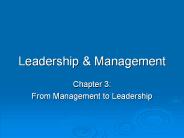Leadership - PowerPoint PPT Presentation
1 / 40
Title:
Leadership
Description:
14-* * * * * The challenge is for managers at all levels to ... 14.2 House s Path-Goal Theory A contingency model of leadership proposing that effective ... – PowerPoint PPT presentation
Number of Views:638
Avg rating:3.0/5.0
Title: Leadership
1
Leadership
- chapter fourteen
2
Learning Objectives
- Explain what leadership is, when leaders are
effective and ineffective, and the sources of
power that enable managers to be effective
leaders. - Identify the traits that show the strongest
relationship to leadership, the behaviors leaders
engage in, and the limitations of the trait and
behavioral models of leadership. - Explain how contingency models of leadership
enhance our understanding of effective leadership
and management in organizations. - Describe what transformational leadership is, and
explain how managers can engage in it. - Characterize the relationship between gender and
leadership and explain how emotional intelligence
may contribute to leadership effectiveness.
3
The Nature of Leadership
- Leadership
- The process by which a person exerts influence
over others and inspires, motivates and directs
their activities to achieve group or
organizational goals.
4
The Nature of Leadership
- Leader
- An individual who is able to exert influence over
other people to help achieve group or
organizational goals
5
Personal Leadership Styleand Managerial Tasks
- Personal Leadership Style
- The specific ways in which a manager chooses to
influence others - shapes the way that manager approaches the other
principal tasks of management.
6
Personal Leadership Styleand Managerial Tasks
- Servant leader
- A leader who has a strong desire to serve and
work for the benefit of others.
7
Leadership Across Cultures
- European managers tend to be more people-oriented
than American or Japanese managers. - Japanese managers are group-oriented, while U.S
managers focuses more on profitability. - Time horizons also are affected by cultures.
8
Sources of Managerial Power
Figure 14.1
9
Power The Key to Leadership
- Legitimate Power
- The authority that a manager has by virtue of his
or her position in the firm. - Reward Power
- The ability of a manager to give or withhold
tangible and intangible rewards.
10
Power The Key to Leadership
- Coercive Power
- The ability of a manager to punish others
- Limited in effectiveness and application can
have serious negative side effects - Examples verbal reprimand, pay cuts, and
dismissal
11
Power The Key to Leadership
- Expert Power
- Power that is based on special knowledge, skills,
and expertise that the leader possesses. - Tends to be used in a guiding or coaching manner
12
Power The Key to Leadership
- Referent Power
- Power that comes from subordinates and
coworkers respect , admiration, and loyalty - Possessed by managers who are likable and whom
subordinates wish to use as a role model
13
Empowerment An Ingredient in Modern Management
- Empowerment
- The process of giving employees at all levels in
the organization the authority to make decisions,
be responsible for their outcomes, improve
quality, and cut costs
14
Leadership Models
- Trait Model
- Focused on identifying personal characteristics
that cause effective leadership. - Many traits are the result of skills and
knowledge and effective leaders do not
necessarily possess all of these traits.
15
Traits and Personal Characteristics Related to
Effective Leadership
Table 14.1
16
Leadership Models
- Behavioral Model
- Identifies the two basic types of behavior that
many leaders engaged in to influence their
subordinates - Consideration, initiating structure
17
The Behavior Model
- Consideration
- Behavior indicating that a manager trusts,
respects, and cares about subordinates.
- Initiating structure
- Behavior that managers engage in to ensure that
work gets done, subordinates perform their jobs
acceptably, and the organization is efficient and
effective.
18
Contingency Models of Leadership
- Contingency Models
- Whether or not a manager is an effective leader
is the result of the interplay between what the
manager is like, what he does, and the situation
in which leadership takes place
19
Contingency Models of Leadership
- Fiedlers Model
- Effective leadership is contingent on both the
characteristics of the leader and of the
situation. - Leader style is a managers characteristic
approach to leadership
20
Fiedlers Contingency Model
- Relationship-oriented style
- leaders concerned with developing good relations
with their subordinates and to be liked by them.
- Task-oriented style
- leaders whose primary concern is to ensure that
subordinates perform at a high level so the job
gets done.
21
Fiedlers Model Situation Characteristics
- Leader-member relations
- extent to which followers like, trust, and are
loyal to their leader
- Task structure
- extent to which the work to be performed is
clear-cut so that a leaders subordinates know
what needs to be accomplished and how to go about
doing it
22
Fiedlers Model Situation Characteristics
- Position Power
- amount of legitimate, reward, and coercive power
that a leader has by virtue of his or her
position in an organization - Determinant of how favorable a situation is for
leading.
23
Fiedlers Contingency Theory of Leadership
Figure 14.2
24
Houses Path-Goal Theory
- A contingency model of leadership proposing that
effective leaders can motivate subordinates to
achieve goals by - Clearly identifying the outcomes that
subordinates are trying to obtain from their
jobs. - Rewarding subordinates with these outcomes for
high-performance and attainment of work goals - Clarifying the paths leading to the attainment of
work goals
25
Path-Goal Leadership Behaviors
- Directive behaviors
- setting goals, assigning tasks, showing
subordinates how to complete tasks, and taking
concrete steps to improve performance.
- Supportive behavior
- expressing concern for subordinates and looking
out for their best interests.
26
Path-Goal Leadership Behaviors
- Participative behavior
- give subordinates a say in matters and decisions
that affect them.
- Achievement-oriented behavior
- setting challenging goals, expecting that they be
met, and believing in subordinates capabilities.
27
The Leader Substitutes Model
- Leadership Substitute
- characteristic of a subordinate or of a situation
or context that acts in place of the influence of
a leader and makes leadership unnecessary. - Members of an organization sometimes can perform
highly without a manager exerting influence over
them
28
The Leader Substitutes Model
- Possible substitutes can be found in
- Characteristics of the subordinates their
skills, experience, motivation. - Characteristics of context the extent to which
work is interesting and fun.
29
Transformational Leadership
- Leadership that
- Makes subordinates aware of the importance of
their jobs are for the organization and how
necessary it is for them to perform those jobs as
best they can so that the organization can attain
its goals
30
Transformational Leadership
- Makes subordinates aware of their own needs for
personal growth, development, and accomplishment - Motivates workers to work for the good of the
organization, not just for their own personal
gain or benefit
31
Being a Charismatic Leader
- Charismatic Leader
- An enthusiastic, self-confident transformational
leader able to clearly communicate his vision of
how good things could be
32
Being a Charismatic Leader
- Charismatic Leader
- Being excited and clearly communicating
excitement to subordinates. - Openly sharing information with employees so that
everyone is aware of problems and the need for
change.
33
Intellectual Stimulation
- Intellectual Stimulation
- Behavior a leader engages in to make followers be
aware of problems and view these problems in new
ways, consistent with the leaders vision.
34
Developmental Consideration
- Developmental Consideration
- Manager supports and encourages subordinates,
giving them opportunities to enhance their
skills and capabilities and to grow and excel
on the job
35
Transactional Leadership
- Transactional Leaders
- Leadership that motivates subordinates by
rewarding them for high performance and
reprimanding them for low performance.
36
Gender and Leadership
- The number of women managers is rising but is
still relatively low in the top levels of
management. - Stereotypes suggest women are supportive and
concerned with interpersonal relations.
Similarly, men are seen as task-focused.
37
Emotional Intelligence and Leadership
- The Moods of Leaders
- Groups whose leaders experienced positive moods
had better coordination - Groups whose leaders experienced negative moods
exerted more effort
38
Emotional Intelligence and Leadership
- Emotional Intelligence
- Helps leaders develop a vision for their firm.
- Helps motivate subordinates to commit to the
vision. - Energizes subordinates to work to achieve the
vision.
39
Example Coach Roy Williams
- Roy Williams is the Mens basketball coach at the
University of North Carolina Chapel Hill. He
has three guiding principles of leadership - Everyone on the team must focus on the same goal.
It's my job to effectively communicate those
goals to the team. - Emphasize those goals every day.
- Understand that although everyone has a common
goal, individuals also have goals, needs, and
dreams that must be cared for.
40
Video Case Google Extends Charitable Giving
- Are Google co-founders Brin and Page servant
leaders? How about Larry Brilliant? - What would you say is the biggest source of Larry
Brilliants power as a leader? - How does google.org illustrate empowerment at
Google?































